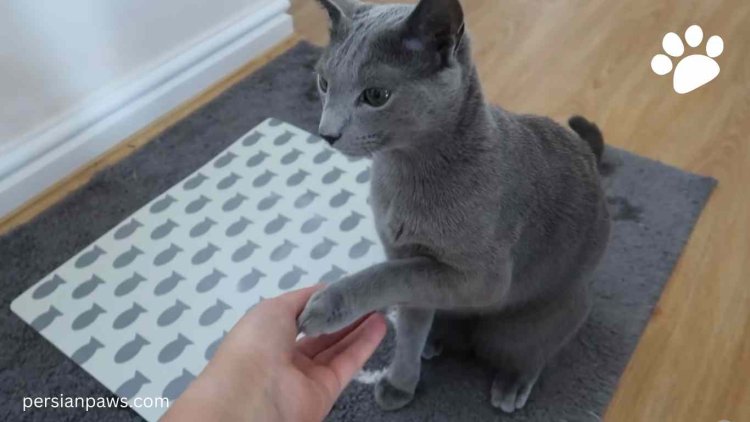Are Russian Blue Cats Aggressive - A Complete Guide
Russian Blue cats are not usually aggressive. They're calm and gentle, known for being friendly and loving towards their owners.

Table of Contents
- Overview of Russian Blue Cats
- Behaviour of Russian Blue Cats
- Behavior in Different Environments
- Factors Influencing Russian Blue Cat Behavior
- Expert Insights
- Managing and Improving Russian Blue Cat Behavior
- 6.1 Tips for Owners
- 6.2 Provide Routine and Stability
- 6.3 Encourage Socialization
- 6.4 Mental and Physical Stimulation
- 6.5 Early Socialization
- Real-Life Experiences and Testimonials
- 7.1 Personal Experience
- 7.2 Case Study
- 7.3 Breeder Testimonial
- 7.4 Addressing Signs of Stress
- 7.5 Shelter Volunteer Observation
- Addressing Aggressive Behavior in Russian Blue Cats
- Testimonials and Cases
- Health and Environmental Factors
- Environmental and Lifestyle Changes
- Conclusion
This comprehensive guide aims to explore the true nature of Russian Blue cats and provide valuable insights into their behavior.
Overview of Russian Blue Cats
History and Origin
The Russian Blue Cat is believed to have originated in the port city of Arkhangelsk, Russia. These cats were reportedly brought to Europe by sailors in the 19th century. Over time, they gained popularity for their unique appearance and friendly temperament.
Physical Characteristics

Russian Blues are medium-sized cats with a muscular build. Their dense, double-layered coat is a hallmark of the breed, characterized by a shimmering blue-gray color. Their eyes are a vivid green, adding to their striking appearance.
Temperament
Russian Blue cats are known for their affectionate but reserved nature. They form strong bonds with their owners but can be hesitant of strangers. Their intelligence and playful nature make them great companions, even though they might seem distant sometimes.
Behaviour of Russian Blue Cats
Are Russian Blue Cats Aloof?
One common misconception is that Russian Blue cats are aloof and detached. While they are not as overtly affectionate as some other breeds, they are by no means cold. Russian Blues are selective in their affections, often forming deep bonds with their primary caregivers.
Behavior in Different Environments
At Home
In a familiar home environment, Russian Blue cats are typically calm and content. They enjoy routine and can become stressed by sudden changes or disruptions.
With Children
Russian Blues can be excellent family pets. Their gentle nature makes them well-suited for households with children. However, it is essential to teach children how to interact with cats respectfully.

With Other Pets
Russian Blues generally get along well with other pets, especially if they are introduced properly. Making friends with other animals when they are young helps them get along well together later.
Factors Influencing Russian Blue Cat Behavior
Genetics, Socialization, and Health Factors
Dr. Karen Becker, an animal behavior specialist, emphasizes the importance of understanding a Russian Blue's unique combination of intelligence and sensitivity. Genetics play a role in shaping behavior, but early socialization and a stimulating environment are crucial for their emotional well-being.
Expert Insights
Dr. Karen Becker:
"Understanding a Russian Blue's unique combination of intelligence and sensitivity is key to nurturing a loving and non-aggressive companion."
"Genetics play a role, but early socialization and a stimulating environment are crucial for a Russian Blue's emotional well-being."
"Contrary to misconceptions, Russian Blues are not inherently aggressive but can become so if their needs for mental and physical stimulation are not met."
Russian Blue Breeders:
"Our experience shows that early socialization, including positive interactions with other pets and children, significantly shapes a Russian Blue's behavior for the better."
"Russian Blues thrive in a consistent and enriching environment. Changes in their routine or surroundings can lead to stress and, in some cases, behavioral issues."
"While they can have health issues sometimes, a well-taken-care-of Russian Blue cat is usually healthy and friendly, not likely to be aggressive."
Managing and Improving Russian Blue Cat Behavior
Tips for Owners
Understanding and managing a Russian Blue's behavior involves patience and consistency. Here are some practical tips:
Provide Routine and Stability
Russian Blues thrive on routine. Try to maintain a consistent schedule for feeding, playtime, and other activities.
Encourage Socialization
Introduce your cat to new experiences gradually. Positive interactions with different people and animals can help reduce fear and promote friendly behavior.
Mental and Physical Stimulation
Provide toys, puzzles, and interactive play to keep your cat mentally and physically stimulated. Boredom can lead to behavioral issues, including aggression.
Early Socialization
Early socialization is crucial for Russian Blue kittens. Exposure to various stimuli, environments, and experiences during the first few months of life can significantly influence their behavior as adults.
Real-Life Experiences and Testimonials
Personal Experience
One Russian Blue owner shares, "Our cat was initially very shy and reserved. However, with regular playtime and interaction, her behavior transformed positively. This experience dispelled the myth of aloofness for us."
Case Study
A case study of a Russian Blue cat being introduced into a household with multiple pets highlights the importance of a carefully managed introduction process. Over time, the cat adapted well and cohabited harmoniously with other pets.
Breeder Testimonial
A Russian Blue breeder emphasizes, "Early socialization is key. Positive interactions with other pets and children significantly shape a cat's behavior for the better."
Addressing Signs of Stress
Another owner shares their experience of recognizing and addressing signs of stress in their cat. "We noticed our cat was more relaxed and less aggressive after we made some environmental changes and provided more enrichment."
Shelter Volunteer Observation
A shelter volunteer observes that even a rescued Russian Blue, despite previous neglect, can adapt and show a gentle nature when given a supportive environment.
Addressing Aggressive Behavior in Russian Blue Cats
Signs of Aggression
Understanding the signs of aggression in Russian Blue cats is essential. Signs include hissing, growling, swatting, and biting.
Handling Aggression
If your Russian Blue exhibits aggressive behavior, consider the following steps:
Identify Triggers: Determine what might be causing the aggression. It could be due to stress, fear, or a medical issue.
Consult a Veterinarian: Rule out any underlying health problems that might be causing the behavior.
Behavioral Training: Work with an animal behaviorist to develop a plan to address and modify the aggressive behavior.
Testimonials and Cases
Recognizing Aggression
One owner shares, "Our Russian Blue exhibited aggression when we moved to a new house. We worked with a behaviorist to identify stressors and gradually reintroduced him to the new environment."
Addressing Aggression

A breeder notes, "Recognizing early signs of aggression and addressing them through positive reinforcement and gradual exposure can make a significant difference."
Health and Environmental Factors
Common Health Issues
Russian Blue cats are generally healthy but can be prone to specific health issues such as urinary tract problems and obesity. Regular veterinary check-ups are essential to ensure their well-being.
Impact on Behavior
Health issues can significantly impact a cat's behavior. Pain or discomfort can lead to aggression or other behavioral changes.
Environmental and Lifestyle Changes
Creating a cat-friendly environment can improve a Russian Blue's behavior. Consider the following:
Safe Spaces: Provide hiding spots and safe areas where your cat can retreat when feeling stressed.
Enrichment: Offer various forms of enrichment, such as climbing trees, scratching posts, and interactive toys.
Routine: Maintain a consistent routine to reduce stress and anxiety.
Conclusion
Russian Blue cats are intelligent, affectionate, and gentle companions. Understanding their behavior, providing early socialization, and creating a stimulating environment is crucial for nurturing a well-balanced cat.
By understanding and addressing the needs of Russian Blue cats, owners can foster a loving and harmonious relationship with their feline friends. Whether you are a current owner or considering adding a Russian Blue to your family, remember that these cats thrive on routine, socialization, and enrichment.
What's Your Reaction?















